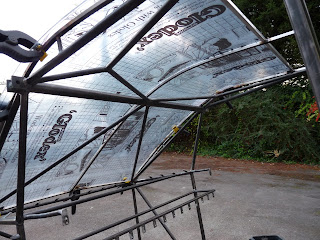
It has been a slow week this week as I've got involved in another aircraft project that is taking time; see
http://www.e-go.me/ for details. However, today I got down to installing the tabs that will support the firewall and the front fuselage cheeks.
43 tabs in all, so that's 239 so far on the fuselage. The front uprights of the fuselage cheeks don't need tabs as they will rivet to the sides of the firewall, a job for late in the build. I also brazed into place the two straps that will fasten round the top of the fuel tank - just visible in the second picture. Final job for the day was to install the capacitive fuel level sender into the fuel tank. Next job is to cut out the combing for the fuel filler tube and test fit the tank - then the tank can be stored out of the way until later.

.
 I started today by final welding the remaining bottom stringer stand-offs. Then all the stringer supports were drilled with a 1/8" drill. The stringers were positioned and cut to length before being match drilled to the supports. As can be seen in the picture these form a nice smooth curve ready to take the fabric. Next the firewall was replaced on the engine mount bolts and the lower part of the firewall was match drilled to it's mounting tabs. A sheet of 0.025" thick 6061-T6 aluminium was then match drilled to the bottom lip of the firewall. The positions of the bends to fit the shape of the stringer support bridge were marked and the sheet bent as can be seen in the picture. The position of the side bends were then also marked and the sheet bent up on each side and cut off just above the lower side mounting tabs. The sides were then match drilled to these tabs. The aluminium side cheeks will overlap the bottom sheet and attach to the same tabs providing a waterproof joint.
I started today by final welding the remaining bottom stringer stand-offs. Then all the stringer supports were drilled with a 1/8" drill. The stringers were positioned and cut to length before being match drilled to the supports. As can be seen in the picture these form a nice smooth curve ready to take the fabric. Next the firewall was replaced on the engine mount bolts and the lower part of the firewall was match drilled to it's mounting tabs. A sheet of 0.025" thick 6061-T6 aluminium was then match drilled to the bottom lip of the firewall. The positions of the bends to fit the shape of the stringer support bridge were marked and the sheet bent as can be seen in the picture. The position of the side bends were then also marked and the sheet bent up on each side and cut off just above the lower side mounting tabs. The sides were then match drilled to these tabs. The aluminium side cheeks will overlap the bottom sheet and attach to the same tabs providing a waterproof joint.




































